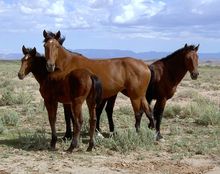The Bureau of Land Management (BLM) and Forest Service (FS) have announced that American taxpayers will again shoulder the burden of government handouts to private livestock operators who graze cattle and sheep on public lands.

Free roaming wild horses
“While the BLM and its ranching allies consistently complain about the $75-million federal wild horse program, they have no problem with the incredibly costly public lands grazing program, which operates deeply in the red every year,”.
© 2014 by Kersti Nebelsiek
The federal government announced that the grossly below market grazing fee of only $1.35 per animal unit month (AUM) will continue for 2014. This is approximately 1/12th the market rate for grazing livestock on private land in the West.[1]
The cost of federal wild horse program pales in comparison to $500 million - $1 billion-a-year public lands grazing program
Livestock grazing on federal lands is estimated to cost taxpayers from $500 million to over $1 billion annually for total direct and indirect costs.[2] Yet the BLM and FS consistently maintain the grazing rates at the lowest rate allowable under federal law, $1.35 per AUM, generating less than $25 million in revenues to these agencies annually. Meanwhile, public lands grazing accounts for less than 1% of U.S. cattle and sheep sales.
“While the BLM and its ranching allies consistently complain about the $75-million federal wild horse program, they have no problem with the incredibly costly public lands grazing program, which operates deeply in the red every year,” said Deniz Bolbol of the American Wild Horse Preservation Campaign (AWHPC).
“During these precarious financial and environmental times, the federal livestock grazing program is clearly not sustainable nor is it supported by the public,” Bolbol continued.
Recent polls which highlight that while 72% of public support protecting wild horses and burros on public lands only 29% of Americans want to ensure that public lands are reserved for livestock grazing.
According to AWHPC, wild horses are removed by the thousands from western public lands to make room for massive livestock grazing. The BLM allocates over 85% of forage in wild horse and burro Herd Management Areas to privately owned livestock, and less than 18% to federally protected wild horses as reported in a survey of 50 HMAs.
The formula used for calculating the grazing fee, which was established by Congress in the 1978 Public Rangelands Improvement Act, has continued under a presidential Executive Order issued in 1986.
Under that order, the grazing fee cannot fall below $1.35 per AUM, and any increase or decrease cannot exceed 25 percent of the previous year’s level. For the last eight years, the grazing fee has remained at the lowest level allowed under law.
About the American Wild Horse Preservation Campaign
The American Wild Horse Preservation Campaign (AWHPC) is a coalition of more than 60 horse advocacy, public interest, and conservation organizations dedicated to preserving the American wild horse in viable, free-roaming herds for generations to come, as part of our national heritage. AWHPC’s founding organization, Return to Freedom (RTF), a national non-profit dedicated to wild horse preservation through sanctuary, education and conservation, also operates the American Wild Horse Sanctuary in Lompoc, CA.
[1-2] According to the Congressional Research Service Report, "The average monthly lease rate for grazing on private lands in 11 western states in 2011 was $16.80 per head."
